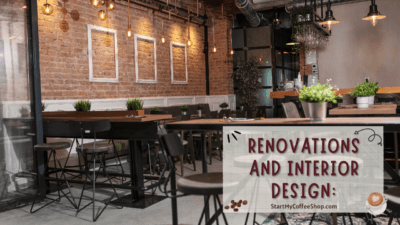Are you dreaming of opening your very own coffee shop? It’s an exciting venture, but before you dive in, it’s crucial to understand the financial aspect. How much does it cost to open a coffee shop?
The average cost to open a coffee shop can vary depending on various factors such as location, size, equipment, and permits. However, it typically ranges from $80,000 to $300,000.
In this article, I will provide you with an analysis of the estimated expenses involved in setting up a coffee shop, ensuring you have a clear understanding of what it takes to turn your dream into reality.
1. Location and Lease Costs:
The location of your coffee shop plays a crucial role in determining its cost. Rent and lease expenses can vary significantly based on the area, city, and even the specific neighborhood you choose. Prime locations in busy city centers come with a premium price tag due to high demand and increased visibility.
On the other hand, suburban or rural areas generally offer more affordable rental options. When selecting a location, consider factors such as foot traffic patterns, proximity to offices or colleges, and overall visibility to attract customers effectively. A bustling urban setting may generate higher sales potential, but it also comes with steeper costs.
A thorough analysis of various location options will help you make an informed decision regarding the best location within your budget constraints.
2. Renovations and Interior Design:
To create a coffee shop that exudes warmth and charm, you’ll need to invest in renovations and interior design. The cost of these enhancements will hinge on factors such as the initial condition of the space, the desired ambiance you wish to create, and the specific design choices you make. Renovations can encompass various aspects such as flooring, painting, lighting, seating arrangements, counter installations, and decorative elements.
Flooring options can range from cost-effective materials like laminate or tile to high-end choices such as hardwood or polished concrete. Painting the walls in inviting colors that align with your brand and theme can significantly enhance the overall atmosphere. Thoughtfully selected lighting fixtures can create an inviting and cozy ambiance, while ample natural light can provide a refreshing and airy feel.

Seating choices should strike a balance between comfort and functionality, considering different seating arrangements such as individual tables, communal areas, or cozy nooks. The counter design should be visually appealing, and practical, and accommodate equipment and storage needs.
Additionally, carefully chosen decor items, such as artwork, plants, or unique coffee-related elements, can add personality and charm to your space.
It’s important to recognize that the overall ambiance of your coffee shop plays a vital role in attracting and retaining customers. Creating a comfortable, visually appealing, and inviting atmosphere fosters a positive customer experience, encourage longer stays, and promotes word-of-mouth recommendations.
Therefore, allocating a sufficient budget for renovations and interior design is essential to transform a mere space into a welcoming haven for coffee enthusiasts and community members.
Read more about Cost to Start Drive-Thru Coffee Shop: A Cupful of Expenses
3. Equipment and Furnishings:
To ensure that you can consistently brew that perfect cup of coffee, investing in high-quality equipment is crucial. Your coffee shop will require a range of equipment, including espresso machines, grinders, coffee makers, blenders, refrigerators, and more. The cost of this equipment can vary significantly based on factors such as your menu offerings and the desired level of quality.
For instance, a commercial-grade espresso machine can range from a few thousand dollars to tens of thousands of dollars, depending on its features and capabilities. Similarly, grinders that offer precise and consistent grinding can also come with a substantial price tag. Coffee makers and blenders suited for specialty drinks and unique recipes may require additional investment.
In addition to coffee-specific equipment, don’t overlook the importance of furniture in creating a pleasant experience for your customers. Budgeting for tables, chairs, couches, and outdoor seating is essential to provide comfortable and inviting spaces for patrons to enjoy their coffee. The quality and style of furniture should align with your coffee shop’s overall aesthetic and target customer base.
Remember, investing in high-quality equipment and furniture sets the foundation for delivering exceptional coffee and ensuring a positive customer experience. While the initial costs may seem significant, choosing reliable and durable equipment will likely save you from frequent repairs or replacements in the long run.
Striking the right balance between quality, functionality, and budget is key to setting up a coffee shop that can consistently deliver the perfect brew while providing a comfortable atmosphere for customers to savor their coffee.
4. Licenses, Permits, and Legal Fees:
Before embarking on the journey of opening your coffee shop, it’s crucial to navigate the intricate landscape of legal requirements. This involves obtaining various licenses and permits to operate your business legally and ensure compliance with local regulations. These licenses and permits typically include health permits, food service licenses, business registrations, and zoning permits.
The cost of these permits can vary significantly based on the location of your coffee shop and the specific regulations imposed by local authorities. Some areas may have higher permit fees than others, and additional costs may be associated with inspections or renewals. It’s essential to research and understand the specific requirements and related costs in your locality.
To ensure a smooth process and avoid any legal complications in the future, it’s advisable to consult with your local authorities or regulatory bodies to gather comprehensive information on the necessary permits and licenses. Additionally, seeking legal counsel or engaging with a business consultant specializing in the food and beverage industry can provide valuable guidance and assistance in navigating legal requirements.
By taking the necessary steps to obtain the required permits and licenses, you not only ensure compliance with regulations but also demonstrate your commitment to operating a legitimate and responsible coffee shop.
5. Staffing and Training:
The primary positions to consider are baristas, who are responsible for crafting and serving the perfect cup of coffee, and cashiers, who handle transactions and interact with customers. Additionally, you may need support staff for tasks like cleaning, stocking, and customer service.
Employee benefits, such as salaries, insurance, and payroll taxes, should also be included in your budget. Determining competitive wages to attract and retain talented individuals is crucial. Offering insurance benefits, such as health and dental coverage, can contribute to employee satisfaction and well-being.
Investing in comprehensive training programs for your staff is vital to ensure consistent quality and customer satisfaction. Proper training not only enhances their skills but also equips them with product knowledge, customer service techniques, and the ability to work efficiently in a fast-paced environment.

Additionally, ongoing professional development and incentives for employee growth can foster a positive work culture and increase staff retention. Remember to allocate resources for continued training and incentives as part of your long-term strategy.
Building a team of passionate and skilled individuals who share your vision and commitment to exceptional service is a valuable investment in the progress of your coffee shop. By providing competitive wages, benefits, and training opportunities, you create an environment that attracts and retains top talent, ultimately enhancing the overall customer experience and setting your coffee shop apart from the competition.
Read more about Cost to Start Dunkin’s Coffee Shop: Analyzing the Cost Factors
6. Initial Inventory and Supplies:
When launching your coffee shop, it’s essential to have an initial inventory of various items that will be crucial to your daily operations. This inventory includes coffee beans, syrups, milk, pastries, and other supplies that align with the variety and quality of products you plan to offer.
To determine the quantities needed, consider factors such as projected demand, customer preferences, and potential menu offerings. Conduct market research and analyze customer trends to estimate the volume of coffee beans, syrups, and milk required on a daily or weekly basis. Ensure you have a robust supply chain in place to replenish your inventory as needed.
In addition to the primary ingredients, stock up on disposable cups, napkins, stirrers, and cleaning supplies. These items are essential for serving your beverages, maintaining cleanliness, and providing a seamless customer experience. Keeping an ample supply of these items helps you manage your daily operations smoothly without disruptions.
Practicing careful inventory management is crucial for controlling costs and minimizing waste. Regularly monitor your inventory levels to prevent overstocking or shortages. Implement inventory tracking systems or software that can help you streamline this process and make informed purchasing decisions. By striking the right balance between maintaining sufficient stock and avoiding excess inventory, you can optimize your operational costs and minimize waste.
Effective inventory management ensures that you can consistently meet customer demand while controlling expenses. It also allows you to identify popular items and adjust your inventory accordingly. By carefully managing your inventory and regularly reviewing and updating your ordering processes, you can maintain a well-stocked coffee shop that caters to the needs and preferences of your customers.
7. Marketing and Advertising:
Creating a website for your coffee shop is a fundamental step in establishing an online presence. Your website should feature an appealing design, highlight your menu offerings, provide information about your location and hours of operation, and offer a convenient way for customers to contact you. Optimize your website for search engines to ensure potential customers can easily find you when searching for coffee shops in your area.
Social media campaigns are powerful tools for building brand awareness and connecting with your target audience. Establish a presence on platforms like Facebook, Instagram, and Twitter, and regularly post engaging content such as beautiful coffee imagery, behind-the-scenes glimpses, promotions, and customer testimonials. Interact with your followers, respond to their comments and messages, and leverage social media advertising options to reach a wider audience.
Consider local advertising options such as print ads, flyers, and local directories to target customers in your immediate vicinity. Collaborate with neighboring businesses to cross-promote each other and increase foot traffic. Additionally, host promotional events like coffee tastings, live music performances, or educational workshops to create buzz and attract new customers.
Remember to track the effectiveness of your marketing efforts and adjust your strategies accordingly. Analyze website traffic, social media engagement, and customer feedback to gauge the improvement of your campaigns. By continually refining your marketing approach, you can maximize your reach, build a loyal customer base, and establish your coffee shop as a go-to destination in your community.
Summary
Opening a coffee shop is an exhilarating journey, but it requires careful financial planning. The estimated cost of opening a coffee shop can vary significantly depending on various factors such as location, renovations, equipment, licenses, staffing, and marketing. By thoroughly analyzing these costs and creating a detailed budget, you can set realistic expectations and increase your chances of growth in the competitive coffee industry.
So, roll up your sleeves, start crunching those numbers, and get ready to serve up some delightful cups of joe in your very own coffee shop!
Frequently Asked Questions

Question: Are there any ongoing expenses involved in running a coffee shop?
Answer: Yes, running a coffee shop involves ongoing expenses such as rent, utilities, inventory replenishment, staff salaries, marketing, and maintenance costs.
Question: Do I need any specific permits or licenses to open a coffee shop?
Answer: Yes. These may include food service permits, health permits, business registrations, and zoning permits.
Question: How much does it cost to purchase coffee shop equipment?
Answer: Generally, equipment such as espresso machines, grinders, and refrigeration units can range from a few thousand dollars to tens of thousands of dollars, depending on your specific needs and preferences.
To learn more on how to start your own coffee shop checkout my startup documents here
Please note: This blog post is for educational purposes only and does not constitute legal advice. Please consult a legal expert to address your specific needs.

Hi! I’m Shawn Chun
My adventure in coffee began when I first launched my first coffee shop back in the early 2000s. I had to figure out so many things on my own and to make it worse within 2 years of opening two large corporate coffee chains moved in just blocks away from me!
As I saw smaller and even some larger coffee shops in the neighborhood slowly lose customers to these giant coffee chains and slowly close up shop, I knew that I had to start getting creative…or go out of business.
I (like you may be) knew the coffee industry well. I could make the best latte art around and the foam on my caps was the fluffiest you have ever seen. I even had the best state-of-the-art 2 group digital Nuova Simonelli machine money could buy. But I knew that these things alone would not be enough to lure customers away from the name brand established coffee shops.
Eventually, through lots of trial and error as well as perseverance and creativity I did find a way to not only survive but also thrive in the coffee/espresso industry even while those corporate coffee chains stayed put. During those years I learned to adapt and always faced new challenges. It was not always easy, however, in the end, I was the sole survivor independent coffee shop within a 10-mile radius of my location. Just two corporate coffee chains and I were left after that year. All told the corporate coffee chains took down over 15 small independent coffee shops and kiosks and I was the last one standing and thriving.
Along the years I meet others with the same passion for coffee and I quickly learned that it is not only “how good a barista is” that makes a coffee shop successful, but the business side of coffee as well.
Hence why I started this website you are on now. To provide the tools and resources for up and coming coffee shop owners to gain that vital insight and knowledge on how to start a coffee shop successfully.
Stick around, browse through my helpful blog and resources and enjoy your stay! With lots of LATTE LOVE!
Shawn







